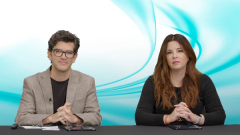
Advancements in Multiple Myeloma IO Therapy: Key Takeaways
Leading experts discuss the evolving landscape of myeloma immunotherapy, highlighting the potential of CAR-T and bispecifics and emphasizing the need for effective management of related toxicities to enhance patient outcomes.
Episodes in this series

Transcript:
Sagar Lonial, MD, FACP: And now we’ve got KarMMA-3 [NCT03651128] and CARTITUDE-4 [NCT04181827] that basically looked at lenalidomide-resistant patients with earlier relapse demonstrating in randomized trials. And randomized trials in CAR Ts, I think, are really important because the intent to treat is really an important end point. We know that a lot of patients are referred for CAR T but don’t actually get to CAR T. And so sometimes what you see in those data is a little bit different. But the randomization, I think, takes some of that out. It’s clearly better than what you would consider standard therapy in the context of lenalidomide-resistant myeloma. Are you ready to move CAR Ts earlier?
Luciano Costa, MD: I totally agree with you. And I think there’s another hidden message on those trials, particularly on CARTITUDE-4, that I think is very interesting. Most of our experience to this point with CAR T is with people who don’t have any good way to control their disease until you get the CAR T, right? People with multirefractory disease. So, a lot of data are infusing CAR T in people with high disease burden, and we know that it’s really a feeder for some of the toxicity.
Now you go on CARTITUDE-4, where the majority of patients have not been exposed to even a CD38 monoclonal antibody. You have a regimen that you use that was in the control arm that becomes the bridging therapy on the cilta-cel [ciltacabtagene autoleucel] arm, which is daratumumab based. Response rates close to 70%. So, you’re getting people treated with a lot less disease, people on the downward slope of their disease burden.
And what you see, which I think is somewhat surprising, is the toxicity looks a whole better than CARTITUDE-1 [NCT03548207], including neurotoxicity. So, I think, you know, that penalty, which is the risk of those long-term, more concerned toxicities is going to be less, is not going to go away, as you use those therapies in people who have better bridging options.
Cesar Rodriguez, MD: The fact that this is moving up front, and we might have access to it as soon as next year, and one, 2, 3 prior lines of therapy, does go with our idea of when you‘re treating myeloma, you want to use your best agents first because you don‘t know if you‘re going to have a second chance or a third chance, or opportunity. So ideally, we’re going to incorporate that in our practice a lot, which is going to give us more questions, like one, are there going to be enough slots?
And if we don’t have enough slots, who are we going to prioritize to get a CAR T? Those who have no more treatment options available, or those who still haven’t been exposed to daratumumab and they’re young and have a chance of cure, that’s going to be a big dilemma… . But in an ideal world, if we had access and all the slots available, definitely I think it’s going to be adopted earlier on so that we can give these patients the best shot at controlling disease and hopefully a durable response.
But also, definitely want to keep in mind, even though the toxicities might be better, we cannot completely ignore the fact that there is these neurotoxicities that are there. And if we’re treating younger patients earlier on without giving them other therapies before a CAR T, is the risk worth the benefit or not?
Sagar Lonial, MD, FACP: I think we’re not going to answer these questions today, but I think it gives us enough work to do in the coming years to try and get better outcomes for everybody. So, as we’re wrapping up here, I want to take just a moment for each of you to give me your key takeaways so the audience can have a quick 1- or 2-sentence summaries on what you’re thinking about. So…we’ll start with Donna.
Donna Catamero, NP: So, with these new immunotherapies, I think we’re seeing deep, durable responses and the goal is really to keep these patients on therapy with the bispecifics, so really mitigating some of those toxicities, infection prevention, helping patients go through with this oral toxicity, this skin toxicity, if we can mitigate those, we can keep patients on therapy.
Sagar Lonial, MD, FACP: Cesar?
Cesar Rodriguez, MD: Having this wave just like we did in 2015 when we started to use daratumumab and we’ve now incorporated it in all of our regimens. This is the next wave of bispecifics and CAR T that I think are going to take over, but I guess the takeaway message would be, I think as we incorporate these we’re learning more about the side effects and toxicities and they are manageable.
We cannot ignore them, but they’re manageable and in the community setting just to keep in mind these toxicities but always try to collaborate and comanage with a specialist so that you don’t overlook something that could potentially put the patient at risk. We definitely want to do the best for the patient and offer them the best shot at giving them a response or a cure if possible, but at the same time we don’t want to give them a quality of life that’s gonna be debilitating for the rest of their life.
Sagar Lonial, MD, FACP: OK, great. Luciano.
Luciano Costa, MD: So, I think that the common theme is something that is not new to myeloma, it just has been broadened and that each relapse we need to be incorporating a new therapy with a new mechanism of action and there’s just now better and more to choose from.
Sagar Lonial, MD, FACP: Great, thank you all and thank you again to our faculty for joining us in this lively discussion on the treatment of patients with relapsed and refractory myeloma brought to you by Cancer Network. And thank you our viewing audience, we hope you found this interactive discussion informative and beneficial to your clinical practice. See you next time.
Transcript is AI-generated and edited for readability.
Newsletter
Stay up to date on recent advances in the multidisciplinary approach to cancer.




















































































